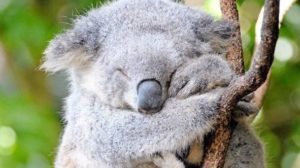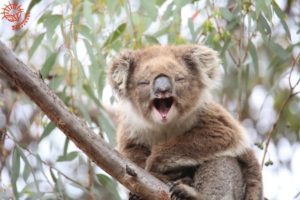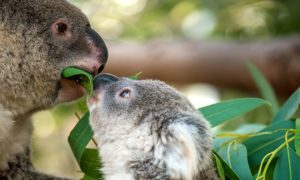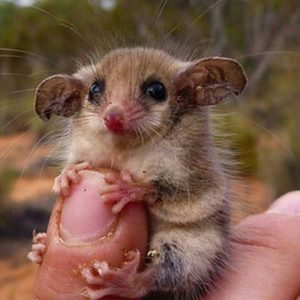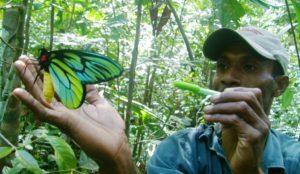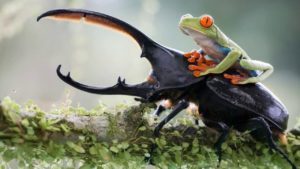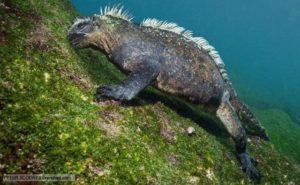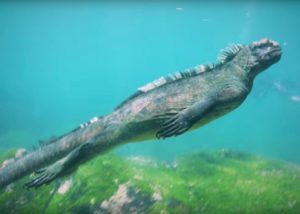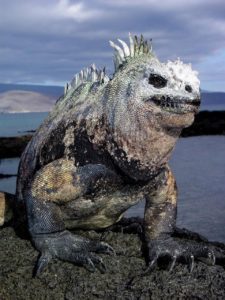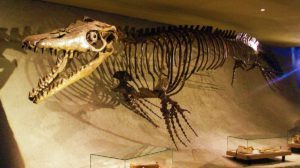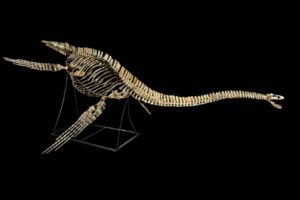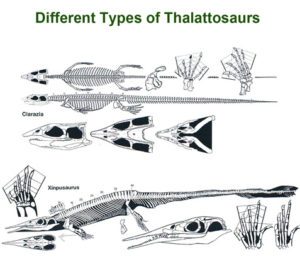Podcast: Play in new window | Download (Duration: 12:20 — 10.4MB)
This week let’s learn about giant tortoises! What’s the difference between a turtle and a tortoise? The most basic difference is that the turtle lives in water and the tortoise lives on land. And there are some really, really big tortoises in the world!
A Galapagos tortoise:
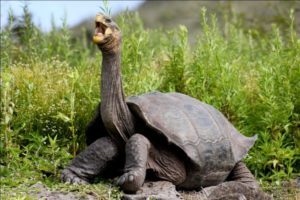
Show transcript:
Welcome to Strange Animals Podcast. I’m your host, Kate Shaw.
This episode was supposed to be about strange reptiles, with more awesome suggestions from listeners. I was going to include some information about a couple of giant tortoises…but the more I researched, the longer that part of the episode became, until it just took over. So here’s an episode about giant tortoises, and we’ll have the strange reptiles episode in a couple of weeks instead. I’m going to give a shout-out to listeners Leo and Finn, who have been waiting patiently to hear their suggestions. Sorry you’ll have to wait a little bit longer.
The biggest tortoise in the world is the Galapagos Tortoise, which as you probably know, or can guess from the name, lives in the Galapagos Islands off the coast of Ecuador. In fact, the islands were named after the tortoises. Galapago means tortoise in Old Spanish. There are eleven species of Galapagos tortoise alive today, but there used to be 15. The others were mostly eaten to extinction by sailors who would stop by the Galapagos Islands, capture tortoises, and sail away with them to eat later.
The biggest individual Galapagos tortoise ever measured was a male named Goliath. When he died in 2002, Goliath was 4.5 feet long, or 1.36 meters, 2 feet three inches high, or 68.5 cm, and weighed 919 pounds, or 417 kg. He was only 42 years old when he died, but Galapagos tortoises frequently live for more than 150 years. Adult tortoises have no predators except humans. They’re just too big, too heavy, too strong, and have too tough a shell for other predators to bother with.
The Galapagos tortoise eats plants, including grass, leaves, fruit, and even cacti. Its neck is long, which allows it to reach plants that are farther away, since it can’t exactly climb trees. It can survive up to six months without water, getting most of its moisture from the plants it eats, but some tortoises on more arid islands will lick dew from rocks to get moisture. Some of the boulders have been licked by tortoises so much over the centuries that they have deep grooves worn in the surface from turtle tongues.
As I’ve mentioned before in other episodes, sometimes herbivores will eat meat when they can get it. The Galapagos tortoise does this too on occasion. There’s a type of finch on the Galapagos that cleans parasites off the tortoises, and to help the finch reach as much of its skin as possible, the tortoise will stand up straight with its legs extended. The finches hop underneath and clean ticks and other parasites from the tortoise’s legs, neck, and the skin between the carapace, or upper shell, and the plastron, the lower shell. But occasionally a tortoise will suddenly pull its legs into its shell and drop, smashing the finches flat. Then it stands up and eats the squashed birds. This is not cool, tortoise. Those birds are trying to help you.
Galapagos tortoises lay round, hard-shelled eggs. The female digs a hole in the dirt that’s about a foot deep, or 30 cm, and lays about a dozen eggs in it. She covers the eggs with dirt, tamps it down with her plastron, and leaves. When the babies hatch, they have to dig their way out of the hole. This can take weeks, but fortunately the babies still have yolk sacs attached that keep them from starving.
One of the Galapagos tortoise species that went extinct recently was the Pinta Island tortoise. The last known individual was called Lonesome George. He was found in 1971 on Pinta Island and taken to the Charles Darwin Research Station on Santa Cruz Island. Although researchers tried to find more Pinta Island tortoises, even offering $10,000 if someone found a female, George turned out to be the very last one. He lived with two females of another Galapagos giant tortoise species, in hopes that they were closely related enough to produce babies, but none of the eggs the females laid ever hatched. Lonesome George died in 2012.
Since then, in 2015, DNA testing on a population of tortoises living on Santa Cruz Island showed that they are a subspecies of their own, and closely related to the Pinta Island tortoises. This had to be an “if only we’d known” moment for the conservationists, who could have paired George with females from that population to produce offspring that were genetically close to the Pinta Island tortoise.
Other Galapagos tortoise species were luckier. The Española Island tortoise was down to only 14 individuals in the wild in 1963. They were all taken to the research station on Santa Cruz Island, joined a few years later by another Española tortoise that had been living in the San Diego Zoo. The breeding program was successful and these days there are over a thousand Española tortoises on the island. Similarly, rats introduced to Pinzón Island in the late 19th century nearly drove that island’s species of tortoise to extinction by eating their eggs and hatchlings. By 1965 there were fewer than 200 adults left alive, and no babies had survived for the better part of a century. Scientists started collecting eggs to incubate in safety at the research station, and rear in captivity until they were big enough to survive rat attacks. By 2012, all the rats had been removed from the island and tortoise nests started to hatch naturally in the wild again.
But the Galapagos tortoise isn’t the only giant tortoise alive. The Aldabra giant tortoise is from the Aldabra Atoll in the Seychelles [pronounced say-SHELZ], a collection of 115 islands off the coast of East Africa. It’s about the same size as the Galapagos tortoise and looks similar, but it’s not closely related. Females lay leathery-shelled eggs in shallow nests. In hot weather, some Aldabra giant tortoises will dig burrows to shelter from the heat. It eats plants and has a long neck like the Galapagos tortoise to reach branches, but unlike the Galapagos tortoise it will sometimes rear up on its hind legs to reach leaves. This is dangerous for a tortoise, because if it topples over on its back, it might not be able to right itself and can die.
Like the Galapagos tortoise, some species of Aldabra giant tortoise have gone extinct in the recent past, and for the same reasons. This included Arnold’s giant tortoise, which lived on one of the central Seychelles islands.
In 1995, the Nature Protection Trust of Seychelles was told about two unusual tortoises in a hotel garden. A couple of scientists went to investigate. The tortoises were both male, extremely old, and appeared to fit the description of Arnold’s giant tortoise, which had supposedly gone extinct over a hundred years before. Where had they come from?
It turns out that the hotel had recently bought the tortoises from a very old local man. They had been in the man’s family for longer than anyone alive could remember. Originally there had been three tortoises, but one had died only a matter of months before the scientists discovered them. They were able to get the dead tortoise’s skeleton for study, which proved that these weren’t just regular old Aldabra giant tortoises, they were Arnold’s giant tortoises—possibly the last two alive in the world.
But the researchers weren’t going to give up that easily. They started digging into reports of other unusual tortoises on the islands. Not only did they eventually find a handful of other Arnold’s giant tortoises, they found a second subspecies that had supposedly gone extinct in 1840, referred to as hololissa after its scientific name, Aldabrachelys hololissa.
As if that wasn’t awesome enough, after all this excitement in the tortoise studying community, the Blackpool Zoo in England took a closer look at the Aldabra giant tortoise that had been living there for the last 25 years, named Darwin. It turns out that Darwin was a hololissa tortoise all along. After that, other zoos brought in experts to examine their giant tortoises, and more hololissa and Arnold’s individuals turned up. The problem is that these tortoises all look pretty much alike except to experts. The tortoises have been placed in a successful captive breeding program in the Seychelles.
Researchers used to think that giant tortoises grew so big due to island gigantism, where a species isolated on an island evolves to become larger. In addition to the Seychelles and the Galapagos, giant tortoises used to live on the Canary Islands and the Mascarene islands, including on Mauritius. You know, where the dodo used to live.
But giant tortoises used to be common all over the world, not just on islands where they mostly live today. Big as these living tortoises are, there used to be giant tortoises even bigger.
The biggest known giant tortoise lived in what is now India and Pakistan, and probably in other places too. It lived around two million years ago and may have only gone extinct about 100,000 years ago, or maybe even more recently. It was twice the size of the Galapagos tortoise, possibly as much as nine feet long, or 2.7 meters, and six feet high, or 1.8 meters.
The giant land tortoise, Hesperotestudo crassiscutata, lived even more recently in North and Central America. It was a little bit larger than the Galapagos tortoise, maybe six feet long, or 1.8 meters, but it went extinct only 12,000 years ago. Researchers think humans may have played a part in driving that tortoise to extinction too, by eating it and its eggs. Since I’m recording this episode on Thanksgiving day in the United States, I’m feeling a little guilty about eating so much turkey. Fortunately, turkeys, unlike giant tortoises, are not endangered.
I’m thankful that some species of giant tortoises have survived until today. They’re awesome animals.
You can find Strange Animals Podcast online at strangeanimalspodcast.com. We’re on Twitter at strangebeasties and have a facebook page at facebook.com/strangeanimalspodcast. If you have questions, comments, or suggestions for future episodes, email us at strangeanimalspodcast@gmail.com. If you like the podcast and want to help us out, leave us a rating and review on Apple Podcasts or whatever platform you listen on. We also have a Patreon if you’d like to support us that way.
Thanks for listening!
